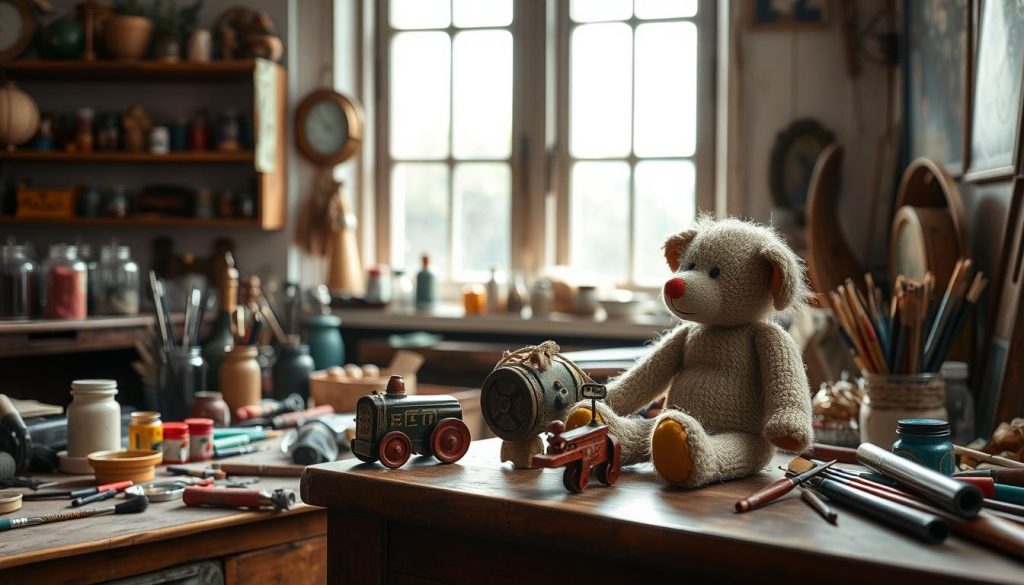Bringing old collectible toys back to life is a rewarding hobby. It mixes the excitement of reliving memories with the joy of refurbishment. Whether you’re fixing toys for fun or to increase their value, knowing the basics is key. We’ll show you how to care for vintage toys, what tools you’ll need, and give tips for effective restoration.
It’s important to assess and prepare before fixing any old toy. Understanding what you’re dealing with and the damage level makes the job easier. Next, we’ll explore these steps in detail, guiding you through the restoration journey.
Key Takeaways
- Understand the basic principles of vintage toy restoration.
- Proper assessment and preparation are crucial before starting.
- The value of collectible toys can be significantly enhanced through restoration.
- Use the right tools and materials for effective retro toy maintenance.
- Learn how to restore old toys effectively by following our step-by-step guide.
Understanding the Importance of Toy Restoration
Restoring classic toys is more than just fixing old items. It’s about keeping memories alive, valuing history, and holding onto personal connections. This guide will show you the deep connection between caring for antique toys and the joy it brings to collectors and those who love nostalgia.
Why Restore Old Toys?
Feeling sentimental is a big reason people care for old toys. They remind us of happy times from our childhood. Restoring these toys brings those memories back and lets us share them with future generations. Also, antique toys show us the design and culture of their time. By fixing them, we keep these cultural treasures safe for everyone to enjoy later.
The Value of Collectible Toys
Restoring classic toys can also make them worth more money. A toy that’s been well fixed can sell for a big price among collectors. If you put time into fixing up old toys, selling them later can bring you a good profit. Also, a toy that looks like new is more exciting at auctions, making it not just beloved, but valuable too.
Preservation vs. Restoration
Preserving and restoring toys are two different things. Preservation means keeping the toy as it is, untouched. Restoration involves fixing and maybe painting the toy to make it great again. Each method has its perks. Preservation keeps the toy’s originality, which is important to those who love history. Restoration, however, brings the toy back to life, making it beautiful and useful again.
When deciding between preserving and restoring, collectors should think about how it affects the toy’s value and its future use. By understanding antique toy care, one can find a good balance between keeping the toy’s original touch and making it appealing again.
Assessing Your Old Toys Before Restoration
Starting restoration on old toys? First, do a deep check. This means figuring out what they’re made of, looking for wear or damage, and seeing if you can actually fix them.
Identifying Materials Used
Knowing what your toy is made from is step one. Each material, like plastic, metal, wood, or fabric, has its own fix-up method. Recognizing these materials helps pick the right cleaners and tools.
Signs of Wear and Damage
Finding out how much repair your toy needs is key. Check for metal rust, color loss on surfaces, plastic cracks, or fabric tears. A good check-up covers all these areas, so you don’t miss anything.

Determining Restoration Feasibility
Deciding if a toy can be fixed is the last step. This means checking its condition, how rare it is, and if you can find what’s needed for the fix. Your checklist should cover:
- Extent of identified wear and damage
- Materials used and their condition
- Availability of replacement parts
- Historical and market value
With careful checking of materials, overall condition, and a solid checklist, fixing up old toys can be a win.
| Assessment Criteria | Details |
|---|---|
| Materials Identified | Plastics, metals, wood, textiles |
| Signs of Wear | Rust, fading, cracks, tears |
| Feasibility Factors | Condition, rarity, available resources |
Essential Tools and Materials for Restoration
Starting toy restoration requires the right tools and materials. Whether you’re new or experienced, having the correct equipment is key. This ensures you can restore toys successfully and be happy with the results.
Basic Tools Every Restorer Needs
A basic toolkit is vital for any toy restoration. It should have different sizes of screwdrivers, small pliers, and precision knives for detailed cuts. You should also get:
- *Magnifying glasses* for close inspections
- *Tweezers* for handling tiny parts
- *Microfiber cloths* for soft cleaning
Cleaning Supplies and Techniques
Cleaning is critical in restoring toys. The right cleaners and methods protect the toy’s old charm. Consider these supplies and techniques:
- Gentle detergents: They clean plastic surfaces without harm.
- Cotton swabs: Good for small spaces.
- Compressed air cans: Dust off fragile areas well.
Always do a spot test with cleaners to prevent damage.
Replacement Parts and Where to Find Them
Sometimes, toys need new parts to look their best again. Finding *vintage toy replacement parts* takes effort and sometimes luck. Try these places:
| Source | Details |
|---|---|
| Online Marketplaces | Etsy and eBay have many vintage parts. |
| Specialty Shops | Dedicated shops often have rare parts. |
| Collectors | Connecting with other collectors can help find parts. |
Using these sources helps make sure your restoration work is successful and authentic.
Step-by-Step Restoration Process
Fixing up old collectible toys is quite rewarding. Doing toy restoration the right way helps keep your precious items looking great for longer. Let’s go through the process bit by bit.
Cleaning Your Old Toys
First things first, how to clean vintage toys is essential knowledge. Start with softly brushing off dust. If dirt sticks around, use a gentle soap mix. Then, with a cotton cloth, carefully wipe the toy, especially around painted sections to prevent damage. Finish up by wiping with a damp cloth and drying it in the air.
Repairing Structural Issues
Fixing any damage requires precision. When repairing antique toys, identify and fix any breaks or weak spots. Choose the right glue for the toy’s material. Add small supports if necessary to make it stronger. Wait until everything’s firmly in place before moving on.
Painting and Finishing Touches
The last phase of step-by-step toy restoration involves painting and final touches. Find a paint that matches the original color of your toy. Apply the paint in thin, smooth layers, letting each one dry fully. Put on a clear varnish to protect the paint and make the toy last longer. Check the toy over for any little details that might need fixing up.
| Restoration Steps | Description |
|---|---|
| Cleaning | Dusting, mild soap solution cleaning, air drying |
| Repair | Fixing broken parts, reinforcing weak spots |
| Painting | Color matching, applying thin paint coats, sealing |
Caring for Restored Toys: Maintenance Tips
Taking care of restored collectible toys is important. You need to know how to display, store, and keep them clean. It’s also vital to fix any damage early to keep them looking great.
Display and Storage Considerations
How you show off your toys matters a lot. Keep them out of direct sunlight to avoid fading. Choose a spot where the temperature and humidity don’t change much. This prevents them from getting damaged.
Consider using display cases with UV-protected glass. This helps protect your toys even more.
Regular Cleaning Recommendations
Create a cleaning schedule for your toys. Use a soft brush or microfiber cloth to gently remove dust. For a deeper clean, a mild soap and water can be used carefully. Make sure the toys don’t stay wet.
Checking your toys often can help you spot and fix problems quickly.
How to Handle Future Repairs
Even with good care, toys might get damaged. Fixing problems right away can stop more serious damage. Use the right tools and materials for the toy you’re fixing.
If a repair is too hard, find a professional who knows about old toys. They can do the job right.

